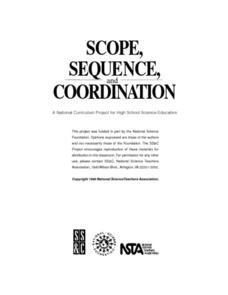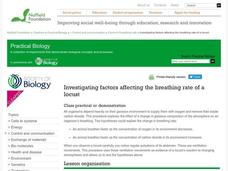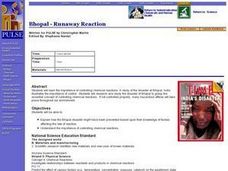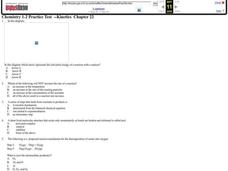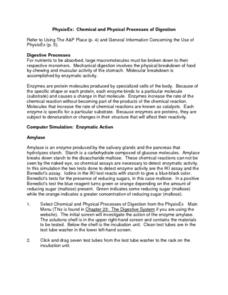Curated OER
Heat, Temperature, and Transfer
Physical science scholars discover an array of heat sources. They experiment to connect radiation to heat. They begin to understand thermal equilibrium. Then, they test to see if mass affects the rate of temperature change. Choose a few,...
Curated OER
Chemical Equilibrium
In this chemical reaction worksheet, students define equilibrium, determine what affects the progress of a reaction, and compare and contrast entropy and enthalpy. This worksheet has 5 fill in the blank, 5 short answer, and 16 problems...
Curated OER
Measuring Reaction Rates
In this chemical reaction worksheet, students determine the rate of consumption or rate of production for given reactions. This worksheet has 14 problems to solve.
Curated OER
Reaction Kinetics
In this chemical reactions worksheet, students determine the reaction rate for various reactions, write balanced equations, create graphs showing the reaction over time, and calculate the activation energy and potential energy. This...
Nuffield Foundation
Investigating Factors Affecting the Breathing Rate of a Locust
Do animals breathe faster when given more oxygen or more carbon dioxide? Young scientists observe the respiration rates of locusts under a variety of gas concentrations to answer that very question. They collect data, analyze the...
Curated OER
Bhopal - Runaway Reaction
Young scholars research and study the disaster of Bhopal to grasp the essential concept of controlling chemical reactions. They explain how the Bhopal disaster might have been prevented based upon their knowledge of factors affecting...
Curated OER
Inquiry into Consumer Products
Students recognize different consumer products, found in and around the home, that have reactive or denaturing properties when used together. They explore chemical and physical properties of each product by identifying chemical formulas...
Cornell University
What Is Rust?
Why do metals rust differently? Scholars experiment with metal combinations in a hands-on activity. They create unique environments with different metals and compare the rate and amount of rust for each.
Curated OER
Rate Determining Step and Catalyst Activity
Students work in groups to stuff as many envelopes as they can in 3-5 minutes. They use an assembly line method. Envelope stuffing is compared to a chemical reactions. The idea of catalyst is considered, and students determine a way to...
Curated OER
Factors Affecting Reaction Rate
Students study the collision theory and explain how the rate of a chemical reaction is influenced by the reaction conditions. In this reactions lesson students divide into groups, discuss the factors that influence reaction rate and...
Curated OER
Concentration and Reaction Rates
Students investigate how varying the concentrations, volumes, and other factors affects reaction rates. Students design and conduct investigations to obtain data used to create graphs of an uncatalyzed reaction vs. a catalyzed reaction....
Beyond Benign
The Green Zine
It's time for your class to advertise what they've learned! The culminating lesson in the 24-part series asks scholars to use their newfound chemistry knowledge to create advertisements. Their magazine advertisements describe the health...
Curated OER
Catalase Enzyme
Young scholars design and conduct an experiment to test their ideas about how to speed up or slow down the rate of an enzyme-catalyzed reaction. They have access to an array of physical and chemical factors that might influence enzyme...
Curated OER
Observation and Stimulation of bioluminescence and chemiluminescence
Students are introduced to chemical reactions, reaction rates, chemiluminescence, fluorescence and bioluminescence. They use glow sticks are used to demonstrate the effect of temperature on the rates of chemical reactions. Pupils recall...
Curated OER
Kinetics
In this kinetics worksheet, students review activation energy, rate of reaction, and reaction mechanisms. This worksheet has 13 multiple choice questions.
Curated OER
PhysioEx: Chemical and Physical Processes of Digestion
In this anatomy worksheet, pupils complete 22 review questions in the format of short answer, table completion, and fill in the blank after finishing an online virtual experiment about the chemical and physical processes of digestion.
Curated OER
Physical and Chemical Changes
Young scholars examine the different changes in matter. In this chemical change lesson plan students determine the amount of reactant made in a reaction using the law of conservation.
Curated OER
Activity #6 How Fast Do Reactions Go?
Students name the factors (concentration, temperature, and a catalyst) which can affect the rate of a chemical reaction. They use their knowledge of particle theory to explain their observations. Pupils comprehend that the...
Curated OER
Activity #19 Oxygen For Yeast
Students observe and record what occurs when yeast is added to hydrogen peroxide. They indicate why a chemical reaction (decompostion) must have occurred during the experiement. Pupils explain why yeast was used. Students comprehend the...
Curated OER
Reaction Rates
Students work in groups of 4-6 for the experiment/activity part of this exercise. They base their explanation on what they observed. Students observe how substances react chemically in characteristic ways with other substances to form...
Curated OER
Energy of Activation
High schoolers determine the activation energy of a chemical reaction.
Teach Engineering
Skin and the Effects of Ultraviolet Radiation
Though UV radiation can damage skin, it isn't all bad. The third installment in a six-part series allows the class to study the structure and function of skin. They learn about the different types of skin cancer and the SPF rating...
Curated OER
Le Chatelier's Principle
For this chemical equilibrium worksheet, young scholars review Le Chatelier's Principle and predict the direction of equilibrium shift for different changes to a chemical reactions. Students also review enthalpy and entropy. This...
Curated OER
Reaction Rates-Catalysis, Concentration, Surface Area, and Temperature
Students determine the meanings of concentration, surface area, and catalysis through an experiment. In this lesson plan about chemical reactions, students participate in an experiment. Students complete three different parts of the...


